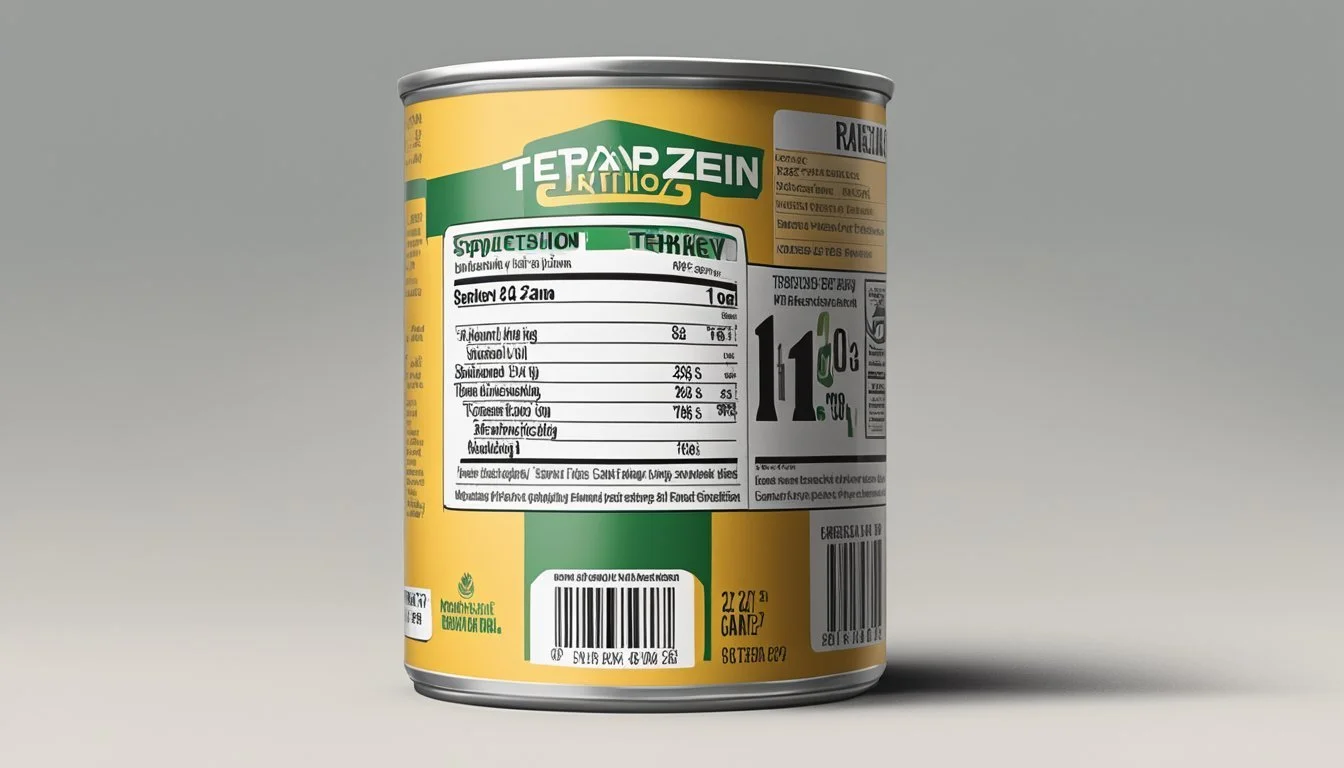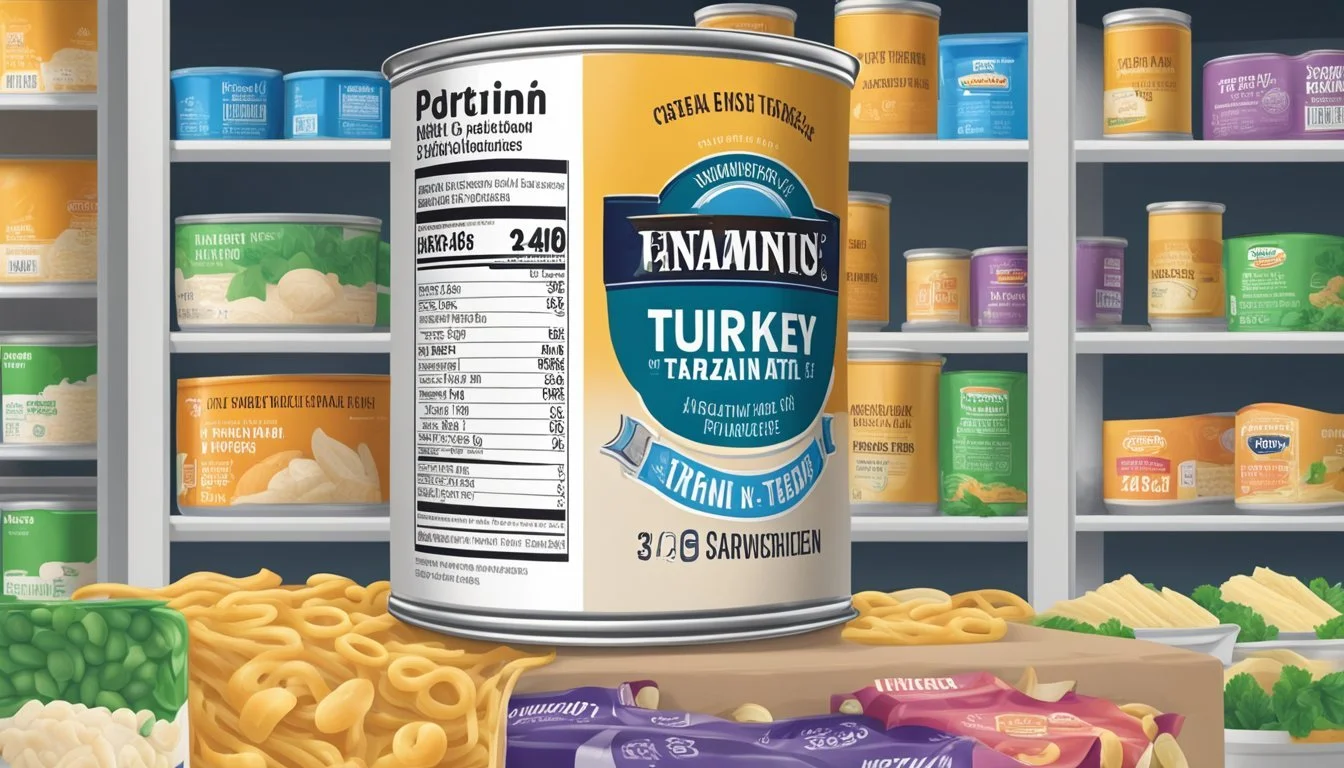Does Canned Turkey Tetrazzini Expire?
Shelf Life and Storage Tips
Canned turkey tetrazzini is a popular and convenient way to enjoy this classic dish, especially when one wants to savor the flavors of Thanksgiving without all the preparation. Yes, canned turkey tetrazzini does expire, and it’s essential to keep an eye on the expiration date printed on the can to ensure it's safe to eat. Consuming expired canned food can pose health risks, so it's better to be cautious.
Typically, canned goods have a long shelf life, often lasting for several years when stored properly. However, their quality and taste can diminish over time. For the best culinary experience, it's advisable to use the canned turkey tetrazzini before its expiration date to maintain its optimal flavor and texture.
Understanding the shelf life of canned turkey tetrazzini can help in meal planning, especially after large gatherings like Thanksgiving when leftovers might be transformed into this creamy, comforting dish. Keeping your canned goods stored in a cool, dry place will help prolong their shelf life and ensure you have a delicious and safe meal when you're ready to enjoy it.
Understanding Food Expiration
When it comes to canned foods like turkey tetrazzini, it's crucial to comprehend what expiration dates signify and how to spot potential spoilage. These insights ensure food safety and prevent unnecessary waste.
Shelf Life of Canned Goods
Canned goods generally boast a long shelf life due to their preservation method. Foods like turkey tetrazzini often remain safe to eat for years. Manufacturers typically stamp a "best by" or "use by" date on the cans. This does not mean the food is unsafe post this date but suggests the timeframe for optimum quality.
Pressure canning is a common method that involves high temperatures to eliminate harmful bacteria. Shelf life often ranges from 2 to 5 years. However, for the best quality, most consumers are advised to consume canned products within this period. Proper storage—cool, dry places away from direct sunlight—plays a significant role in extending shelf life.
Spotting Spoilage in Canned Foods
Canned foods, including turkey tetrazzini, can exhibit signs of spoilage even before the printed date. Key indicators include bulging, rust, or dents in the can. If a can exhibits these signs, it should be discarded regardless of the expiration date.
Unpleasant odors or strange colors when opened are other red flags. If the food smells odd or appears discolored, it's best to err on the side of caution and not consume it. Tiny bubbles or spurting liquid upon opening could indicate the presence of bacteria. Hence, vigilant inspection during and after opening cans is essential for safety.
Turkey Tetrazzini Specifics
Turkey Tetrazzini encompasses a mix of essential ingredients that all have specific storage needs to ensure longevity. Understanding these components and their optimal storage conditions will help keep this dish fresh and delicious.
Composition and Preservability
Turkey Tetrazzini typically contains turkey, pasta, vegetables (like mushrooms and celery), and dairy-based components such as cream, cheese, and butter.
These ingredients are perishable and significantly impact the dish's shelf-life. Leftovers often include added preservatives in canned versions, which extend the expiration period. Without preservatives, homemade versions are more susceptible to spoilage. Canned soup-based tetrazzini can last longer due to additives, whereas freshly cooked varieties should be consumed within a few days when stored properly in the fridge.
Optimal Storage Conditions
Proper storage conditions are crucial for maintaining the quality of Turkey Tetrazzini. Leftovers should be transferred to an airtight container and refrigerated within two hours of preparation.
In the refrigerator, Turkey Tetrazzini can typically last for 3-4 days. For longer storage, freezing is advisable. When stored in the freezer, tightly sealed in an airtight container or heavy-duty freezer bag, the dish can remain good for up to 2-3 months. Label the container with the date to keep track of storage time and ensure quality.
Defrosting should be done in the refrigerator overnight, not at room temperature, to ensure safety. Reheat thoroughly before serving.
Preparing Turkey Tetrazzini
Turkey Tetrazzini combines a creamy sauce with tender pasta and succulent leftover turkey. Below are the detailed steps to assemble ingredients and cook this savory dish.
Assembling the Ingredients
To make Turkey Tetrazzini, start by gathering leftover turkey, pasta (typically spaghetti), and a creamy sauce. The creamy element can be enhanced with cream of mushroom soup or a homemade roux.
You'll also need cheese—Parmesan is popular, as well as butter for rich flavor. Make sure to preheat the oven to 375℉ and butter a 9x13 inch baking dish.
Other key ingredients include mushrooms and aromatics like garlic and onions, which should be sautéed for depth of flavor. Don’t forget to have chicken broth and milk for the sauce base and seasonings like salt, pepper, and a dash of cayenne for mild heat.
Cooking Procedures and Techniques
Start by cooking the pasta in heavily salted boiling water until just al dente. Reserve a bit of the pasta's cooking water. In a large pot, melt butter and sauté the mushrooms, garlic, and onions until they soften.
Whisk together flour and milk to create a smooth slurry, then add this to your pot along with chicken broth. Bring to a boil, then lower to a simmer, stirring until thickened. Add cream cheese if desired, stirring until melted.
Incorporate shredded leftover turkey, cooked pasta, and reserved pasta water into the sauce. Transfer the mixture to the pre-buttered baking dish and top with cheese.
Bake in the preheated oven for about 25 minutes or until the top is golden and bubbly. This creates a perfect balance of flavors and textures—rich, creamy, and full of comforting goodness.
Serving and Presentation
Proper serving and presentation can elevate canned turkey tetrazzini, enhancing both its visual appeal and taste experience. It involves not only choosing the right accompaniments but also carefully plating and garnishing the dish for an inviting meal.
Dish Accompaniments
Turkey tetrazzini pairs wonderfully with a variety of sides. Green salads with fresh lettuce, cucumber, and cherry tomatoes provide a crisp contrast to the creamy pasta. Adding a zesty salad dressing can enhance the fresh flavors.
Serving roasted asparagus adds a nutritious touch, featuring high levels of vitamins A, C, and K, along with fiber and antioxidants. Simply toss asparagus with olive oil, salt, and pepper, then roast at 400°F until tender.
For added texture, consider a side of toasted garlic bread. The crunch of the bread complements the softness of the tetrazzini, providing a satisfying variety of textures in each meal.
Plating and Garnishing
Careful plating turns canned turkey tetrazzini into a visually appealing dish. Begin by spooning a generous portion onto a warm plate to keep the dish at the optimal temperature.
Top the dish with a light sprinkle of shredded cheese to melt over the hot tetrazzini, adding an extra layer of flavor and richness. A dash of breadcrumbs can also be sprinkled on top before baking or reheating to create a crispy crust.
Enhance the presentation with a sprig of fresh parsley placed strategically to add a touch of green. This not only adds color but a hint of freshness. Finally, consider a side of the previously mentioned green salad, placed beside the tetrazzini on the same plate.
These plating and garnish choices turn a simple meal into an enticing feast.
Storage and Preservation
Proper storage and preservation techniques for canned turkey tetrazzini are crucial for maintaining its quality and safety. This section provides detailed guidelines on refrigeration best practices and the correct methods for freezing and thawing.
Refrigeration Best Practices
After opening, canned turkey tetrazzini leftovers should be transferred to an airtight container to prevent moisture loss and contamination. Store the container in the fridge and ensure the temperature is consistently below 40°F (4°C).
Reheat the dish within 3-4 days of refrigeration. Always reheat to an internal temperature of 165°F (74°C) to ensure safety. Avoid leaving the tetrazzini at room temperature for more than 2 hours, which can lead to bacterial growth.
Freezing and Thawing
To freeze turkey tetrazzini, cool it down first, then portion it into freezer-safe, airtight containers or heavy-duty freezer bags. Leave space for expansion. Proper labeling with the date helps in tracking how long the food has been frozen.
When ready to reheat, thaw the tetrazzini overnight in the fridge. Reheat it thoroughly to an internal temperature of 165°F (74°C). For quicker thawing, use the defrost setting on a microwave, but this can lead to uneven heating. Never refreeze partially thawed food.
Reheating Guidelines
To reheat canned turkey tetrazzini effectively, the two most popular methods are using a microwave or a conventional oven. Each method has steps that ensure the best flavor and safe consumption of the leftovers.
Microwave Reheating Instructions
Using a microwave to reheat turkey tetrazzini is quick and efficient.
Transfer to Microwave-Safe Dish: Move the desired amount of tetrazzini into a microwave-safe dish.
Add Moisture: Pour a small amount of water, broth, or stock over the tetrazzini to prevent it from drying out.
Cover: Loosely cover the dish with microwave-safe plastic wrap or a microwave-safe lid.
Heat: Set the microwave on medium power and heat for 2-3 minutes.
Stir: After the initial heating, stir the tetrazzini to distribute heat evenly.
Continue Heating: Microwave for another 1-2 minutes or until the internal temperature reaches 165°F (74°C).
Rest: Let it sit for a minute to cool slightly before serving.
Conventional Oven Method
Reheating turkey tetrazzini in an oven helps achieve even heating and can enhance its texture.
Preheat Oven: Set your oven to 350°F (175°C).
Transfer to Oven-Safe Dish: Place the turkey tetrazzini in an oven-safe dish, such as a casserole or baking dish.
Add Moisture: Lightly sprinkle chicken broth or stock over the tetrazzini to maintain moisture.
Cover: Loosely cover the dish with aluminum foil to prevent the top from burning while heating.
Bake: Put the covered dish in the preheated oven. Bake for approximately 15-20 minutes, until heated through.
Check Temperature: Ensure that the internal temperature reaches 165°F (74°C) for safe consumption.
Serve: Remove from the oven, let it cool briefly, and serve.
Adjust the timing based on the quantity and density of the tetrazzini.
Nutrition and Diet Considerations
Canned turkey tetrazzini can offer nutritional benefits, but certain factors must be considered for calorie count and health adjustments.
Caloric Information
Canned turkey tetrazzini typically includes ingredients like turkey, pasta, mushrooms, and a creamy sauce. This combination can be quite calorific. A standard serving of canned turkey tetrazzini may contain anywhere from 250 to 450 calories per serving.
Factors such as the type of pasta and the richness of the cream sauce contribute to the caloric content. For those tracking their calorie intake, it's essential to read the nutrition label.
Often, the label also lists serving size, making it easier to control portions.
Dietary Adjustments for Health
For individuals watching their sodium intake, canned foods can be high in salt. It is beneficial to look for low-sodium versions or to rinse the food before heating.
Substituting regular pasta with whole grain can improve the nutritional profile significantly. Whole grain pasta contains more fiber, aiding in digestion.
Some versions of canned turkey tetrazzini might include additives and preservatives.
Opting for brands with minimal additives or making homemade versions can reduce the consumption of these substances. Using low-fat or non-dairy cream alternatives can also decrease fat content, making the meal lighter while maintaining flavor.









